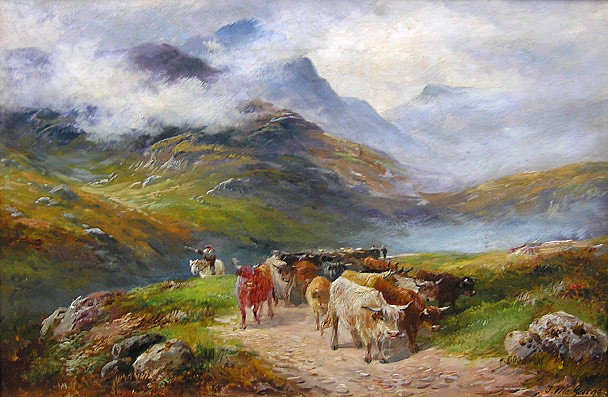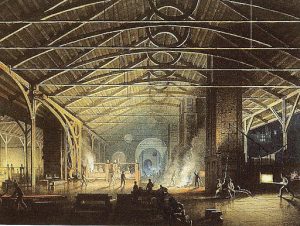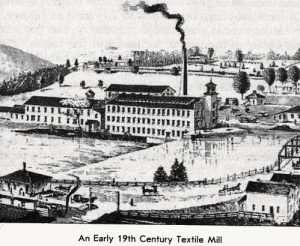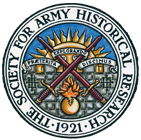The Country at Arms
As the needs of war developed, from Whitehall to Whitehaven, the whole country was converted into a war economy.
Intelligence and communications became a major concern as Napoleon’s victorious armies swept across Europe (See the ‘Alien Office’ chapter theme in the London theme). Britain’s army and navy required up to date intelligence about enemy movements by land and sea. The Royal Navy’ s advanced station in the Channel was on the island of Guernsey where Captain Phillipe Auvergne’s squadron of cutters and fishing boats kept watch on the French coast for any sign of the French fleet emerging from its home ports or the assembly of barges that could be used for an invasion. In London, the Secret Office of the Post Office intercepted continental mail and the staff of the Alien Office followed, captured and executed enemy spies.
Droving & Trooping
The peace time army and navy had numbered c.90, 000 but numbers in wartime increased dramatically. Food in both the army and navy was notoriously bad but in war, the troops and seamen needed adequate rations to fight. By 1801, Britain was feeding over 400,000 mouths each day, of whom 126,000 were at sea and 248,000 were serving on land throughout the world, from Canada and the West Indies to the Mediterranean, India and the Far East. At the war’s height, after the Treaty of Amiens of 1804 had broken down, Britain was deploying up to 14% of it6s adult population in its armed services which was up to three times more than its enemy, France.
A Victualling Board was set up in Somerset House with yards on the Thames at Deptford and a mega-mill at Rotherhythe. A Transport Board chartered merchant vessels for the transport of men and materiel, many of which came from the East India Company’s fleet. Victualling agents were hired in every port in England and were contracted to supply goods and services. The newly improved canal system was used to move supplies and at Weedon in Nottinghamshire a great national supply depot was established using the newly opened Grand Union Canal and Britain’s network of inland waterways.
1.7 gallons of beer were brewed for military consumption and 50,000 pigs were reared annually in the Home Counties, close to
London. Farmers, drovers, graziers and shepherds brought in their herds and flocks from all over Britain and cows were shod with iron shoes and driven along drover’s roads to the capital.
Cattle from as far away as the island of Anglesey were swum across the Menai Straights at low tide before being driven through Wales towards East Anglia where they were fattened for sale. Ships of the Line carried 30 live store cattle and frigates were allowed 20.

First raters carried 40 tons of coal for cooking on board and the Victory carried 380 tons of fresh water. In February and June 1801, two fleets of transports took over 3,000 tons each to troops deployed in the Mediterranean theatre. Transporting cavalry was a long and complex process and too up large numbers of transports. Lieutenant colonels were allocated five horses, Majors four and so on down the ranks in addition to pack animals for baggage. Twenty- six ships were required to transport six cavalry regiments to the Peninsular in specially adapted horse-ships.
In addition to the Navy’s fifty-three troop ships, the East India Company made available a further six large East Indiamen at no cost to the Government to transport troops to the East.
The Wartime Economy
 Britain’s economy thrived during the war. The Government was able to raise taxation and obtain corporate and international loans that were spent on the provisions of war and its overseas trade was continued through its mastery of the oceans.
Britain’s economy thrived during the war. The Government was able to raise taxation and obtain corporate and international loans that were spent on the provisions of war and its overseas trade was continued through its mastery of the oceans.
(See the ‘Empire of the Oceans’ chapter in the Atlantic & Oriental Worlds theme).

While much of Britain’s industry was driven by water, wind and horse-mills, steam engines were i8n increasing use. Cotton production increased three times between the mid-1790s and 1815 and steel increased fourfold. Canals and docks were dug, including the great East India Dock at Blackwell.
Steam engines kept the docks dry and steam dredgers swept the river.
Colonel Shrapnel’s bursting shells and William Congreve’s rockets changed battlefield tactics and the Ordnance Office with its small arms factory in Lewisham, South London, manufactured 50,000 sets of rifles and muskets a year whilst its laboratory and factory at Woolwich employed over 1.400 tradesmen.
The success of the wartime economy came at a heavy cost and by its end much blood and treasure has been spent. Peace brought not only the return of soldiers who faced unemployment as wartime production was run down but also an unsustainable level of national debt that required urgent action. However, Britain’s possessions throughout the world had been secured and after a period of recession and consolidation her national economy expanded once more.

